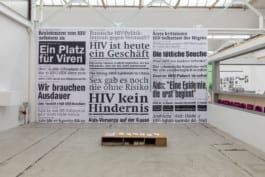
Shedhalle (Zurich, Switzerland)
‘Problem gelöst? Geschichte(n) eines Virus’
2019
Exhibition architecture
Thanks to advancements in medicine, HIV/Aids has largely lost its initial horrific character. Nowadays – at least in Western countries – having HIV no longer means facing a certain death sentence. Shedhalle, Zurich’s centre for contemporary arts with a critical eye towards socio-political developments, asked us to design the architecture for an exhibition about how HIV has affected society over the years.
With its interdisciplinary approach, the exhibition ‘Problem gelöst? Geschichte(n) eines Virus’ [Problem solved? Stories of a virus] sought to tell the socio-political and aesthetic history of the Aids crisis of the 1980s and 1990s from the point of view of those who were most affected. Focusing on the situation in Switzerland and in the city of Zurich in particular, the exhibition traced the “social aesthetics” stemming from the loss of individuals but also the simultaneous emergence of communities based on solidarity.
A range of topics helped to illustrate the socio-political complexity of the time: community; the culture of mourning and remembrance; developments in the general mood in society; the financial opportunities stemming from the HIV/Aids crisis (e.g. fluctuations in the price of latex); medication and medical research; the period between AZT and PrEP; HIV and the ageing process. Each topic centred around a video interview with someone who had been living with HIV since the start of the crisis. These oral histories describe the perspectives of gay men, women, children, sex workers, drug users, recipients of blood transfusions and people who seroconverted through sex or during birth.
Upon entering the exhibition, visitors passed through a wall-to-wall curtain of HIV/Aids-related newspaper headlines from the very beginning of the crisis up to the present. The next thing they saw was a three-dimensional model describing the extent of the HIV/Aids crisis in Switzerland. The Shedhalle’s 700-square-metre space was divided into the various different thematic spaces that Rayelle Niemann put together, where historical background, art, and documentation were combined with personal oral histories. There was information on social history and the club scene in Zurich, for example, but also further statistical information describing the current situation with HIV/Aids both in Switzerland and internationally. For each section we chose a different design. The wall behind the social history section was papered in black and white, for example. For those who wanted to sit down to listen to the oral histories, seating was available in the form of pill boxes and pill-shaped sofas.
Concept: Gerhard Hintermann, Sarah Merten, Rayelle Niemann, Christoph Studer-Harper
Curator: Rayelle Niemann
Photography: Thomas Eugster
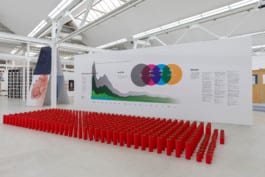
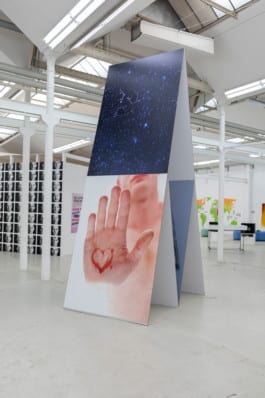
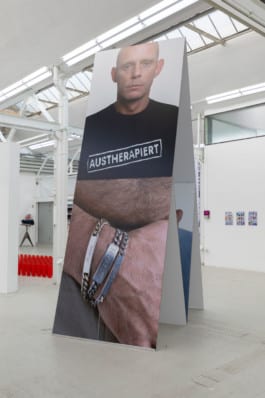
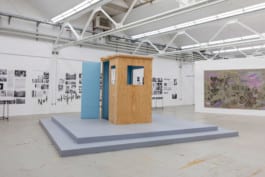

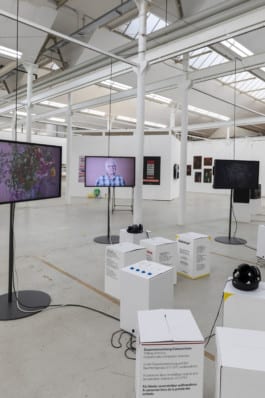
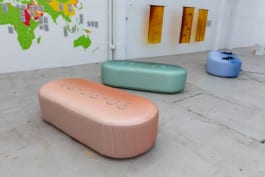
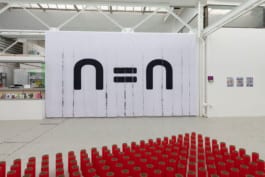
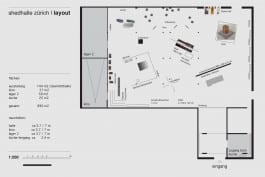
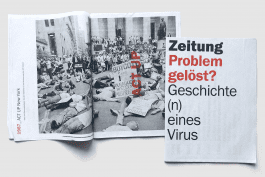

Shedhalle (Zurich, Switzerland)
‘Problem gelöst? Geschichte(n) eines Virus’
2019
Exhibition architecture
Thanks to advancements in medicine, HIV/Aids has largely lost its initial horrific character. Nowadays – at least in Western countries – having HIV no longer means facing a certain death sentence. Shedhalle, Zurich’s centre for contemporary arts with a critical eye towards socio-political developments, asked us to design the architecture for an exhibition about how HIV has affected society over the years.
With its interdisciplinary approach, the exhibition ‘Problem gelöst? Geschichte(n) eines Virus’ [Problem solved? Stories of a virus] sought to tell the socio-political and aesthetic history of the Aids crisis of the 1980s and 1990s from the point of view of those who were most affected. Focusing on the situation in Switzerland and in the city of Zurich in particular, the exhibition traced the “social aesthetics” stemming from the loss of individuals but also the simultaneous emergence of communities based on solidarity.
A range of topics helped to illustrate the socio-political complexity of the time: community; the culture of mourning and remembrance; developments in the general mood in society; the financial opportunities stemming from the HIV/Aids crisis (e.g. fluctuations in the price of latex); medication and medical research; the period between AZT and PrEP; HIV and the ageing process. Each topic centred around a video interview with someone who had been living with HIV since the start of the crisis. These oral histories describe the perspectives of gay men, women, children, sex workers, drug users, recipients of blood transfusions and people who seroconverted through sex or during birth.
Upon entering the exhibition, visitors passed through a wall-to-wall curtain of HIV/Aids-related newspaper headlines from the very beginning of the crisis up to the present. The next thing they saw was a three-dimensional model describing the extent of the HIV/Aids crisis in Switzerland. The Shedhalle’s 700-square-metre space was divided into the various different thematic spaces that Rayelle Niemann put together, where historical background, art, and documentation were combined with personal oral histories. There was information on social history and the club scene in Zurich, for example, but also further statistical information describing the current situation with HIV/Aids both in Switzerland and internationally. For each section we chose a different design. The wall behind the social history section was papered in black and white, for example. For those who wanted to sit down to listen to the oral histories, seating was available in the form of pill boxes and pill-shaped sofas.
Concept: Gerhard Hintermann, Sarah Merten, Rayelle Niemann, Christoph Studer-Harper
Curator: Rayelle Niemann
Photography: Thomas Eugster










